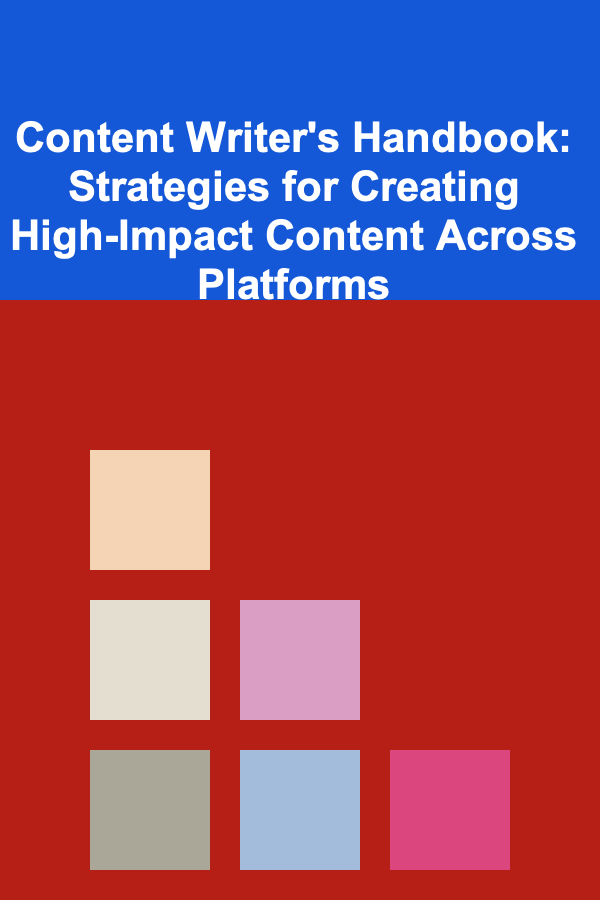
Content Writer's Handbook: Strategies for Creating High-Impact Content Across Platforms
ebook include PDF & Audio bundle (Micro Guide)
$12.99$10.99
Limited Time Offer! Order within the next:

In today's digital landscape, content is king. However, in a world inundated with endless information, standing out requires more than just writing. Content writers need to be strategic, adaptable, and creative in crafting messages that resonate with diverse audiences across a variety of platforms. Whether you are writing for blogs, social media, email campaigns, or corporate websites, the core principle remains the same: the content must be engaging, purposeful, and value-driven.
This actionable guide provides comprehensive strategies for content writers to create high-impact content that not only captures attention but also fosters deeper engagement and drives results.
Understand Your Audience Deeply
Creating content that connects with an audience starts with a clear understanding of who they are. A one-size-fits-all approach no longer works in the age of personalized content. To craft meaningful content, you must understand the unique characteristics, needs, and behaviors of your target audience.
Audience Research
- Demographic Data: Start with basic demographic information such as age, gender, location, and job titles. Tools like Google Analytics, social media insights, and surveys can provide valuable data about your audience's characteristics.
- Psychographics: Dive deeper into the attitudes, values, and interests of your audience. What motivates them? What are their pain points? This deeper understanding helps in creating content that speaks directly to their needs and aspirations.
- Buyer Personas: Create detailed buyer personas that represent your ideal readers. Include information about their goals, challenges, preferences, and media consumption habits. These personas serve as a reference when writing, ensuring the content is tailored specifically to their context.
By researching your audience extensively, you will be able to craft messages that resonate on a personal level, increasing the chances of engagement and conversion.
Tailor Content to the Platform
Each platform has its unique characteristics, user expectations, and content consumption patterns. A blog post may work wonders on a website, but that same content could flop on social media. Understanding the nuances of different platforms is crucial for creating content that performs well.
Platform-Specific Strategies:
- Blogs: In-depth, informative, and well-researched content is often most effective on blogs. Readers who come to blogs tend to seek answers to questions or solutions to problems, so your content should be focused on providing value. Use a clear, structured format with headings, subheadings, and bullet points to make the post scannable. Additionally, SEO optimization is crucial for blog content to rank on search engines.
- Social Media: On platforms like Instagram, Twitter, and Facebook, brevity and visual appeal are key. Audiences are typically scrolling quickly through their feeds, so you need to capture their attention immediately. Use attention-grabbing headlines, concise language, and high-quality visuals (images, infographics, videos) to enhance engagement. Hashtags and calls to action (CTAs) should be strategically included to increase reach and engagement.
- Emails: Email content must be clear, concise, and focused on value. Email subscribers often have limited time and attention spans, so the subject line needs to be compelling enough to entice them to open the email. Personalization, relevant offers, and a strong CTA are vital for effective email content.
- Websites: Website content should provide value to both users and search engines. It should be easy to navigate, mobile-friendly, and optimized for SEO. Users expect concise, informative content that helps them make decisions quickly, so product descriptions, service overviews, and FAQs should be clear and direct.
Content Types by Platform:
- Blogs: Long-form articles, guides, case studies, product reviews.
- Social Media: Short posts, stories, carousels, videos, infographics.
- Emails: Newsletters, promotional emails, transactional emails.
- Websites: Landing pages, product/service descriptions, testimonials.
By understanding how content is consumed on each platform, you can optimize your approach to ensure the message is received in the right way.
Craft Attention-Grabbing Headlines
The headline is often the first (and sometimes only) impression you make on a potential reader. Crafting compelling headlines is an art form, and it plays a critical role in determining whether your content will be clicked, read, and shared.
Headline Writing Techniques:
- Use Numbers: People love lists. Headlines like "10 Ways to Improve Your Writing" or "5 Key Strategies for Boosting Engagement" catch the eye because they promise a structured, easy-to-digest list.
- Ask Questions: Asking a question in the headline sparks curiosity. For example, "Are You Making These 5 Content Mistakes?" or "What's Holding Your Content Back?"
- Create Urgency: Phrases like "Right Now," "Don't Miss Out," or "Before It's Too Late" can generate a sense of urgency that prompts immediate action.
- Make a Bold Statement: Headlines that challenge common perceptions or promise valuable insights are more likely to grab attention. For example, "Why Traditional Marketing is Dead" or "How I Doubled My Content Engagement in 30 Days."
- Incorporate Keywords: SEO is essential, so including relevant keywords in your headlines can boost visibility on search engines, driving more traffic to your content.
Remember, a great headline should promise something of value, whether that's a solution to a problem, an answer to a question, or a new perspective on an issue.
Focus on Readability and Clarity
Even the best content will fall flat if it's difficult to read. Clear, concise, and well-structured content ensures that your message is communicated effectively. As a content writer, it's important to focus on readability to keep your audience engaged.
Tips for Enhancing Readability:
- Short Paragraphs: Break content into digestible chunks by using short paragraphs. Long blocks of text can overwhelm readers, especially on the web.
- Simple Language: Avoid jargon and complex vocabulary unless your audience specifically demands it. The goal is to communicate your message as clearly as possible.
- Headings and Subheadings: Use headings and subheadings to create a clear structure. This makes it easier for readers to navigate the content and find the information they need.
- Bullet Points and Lists: Lists help break up text and make key points stand out. Bullet points allow readers to quickly scan content and absorb the most important information.
- White Space: Make sure your content has enough white space around it. Crowded content can make it harder for readers to focus and absorb your message.
By improving readability, you increase the chances of your audience staying on your page longer, engaging with the content, and returning for more.
Incorporate SEO Best Practices
Search engine optimization (SEO) is essential for ensuring your content gets discovered. Even the best-written content will go unnoticed if it's not optimized for search engines. To boost visibility, integrate SEO techniques without sacrificing the quality of the content.
SEO Writing Strategies:
- Keyword Research: Identify relevant keywords for your content by using tools like Google Keyword Planner, SEMrush, or Ahrefs. Integrate these keywords naturally into your content, especially in titles, headers, and the first 100 words of the article.
- Optimize for Featured Snippets: Featured snippets are the boxed answers that appear at the top of some Google search results. Structuring your content to answer common questions and using bullet points or numbered lists can increase your chances of appearing in a featured snippet.
- Internal and External Links: Use internal links to guide readers to other relevant content on your site. External links to authoritative sources not only enhance credibility but also improve SEO.
- Image Optimization: Images should be properly labeled with descriptive alt text, which also helps improve SEO. Large image files should be compressed to improve page load times.
By focusing on SEO, you can increase organic traffic to your content and improve its visibility across search engines.
Engage and Call to Action (CTA)
Engagement is at the heart of successful content. Your content should prompt your audience to take action---whether it's leaving a comment, sharing the content, or clicking on a link. A strong CTA is a vital part of this process.
CTA Best Practices:
- Be Specific: Tell your audience exactly what you want them to do. Instead of just saying "click here," try "Download the free e-book" or "Sign up for the webinar today."
- Create Urgency: Encourage immediate action by creating a sense of urgency. For example, "Register now before spots run out!" or "This offer ends in 24 hours."
- Provide Value: Offer something of value in exchange for taking action. For example, "Get access to our free content calendar template" or "Subscribe for weekly tips on content strategy."
- Visibility: Ensure your CTA stands out visually. It should be easily noticeable within the content, whether it's a button, hyperlink, or banner.
By making your CTAs clear, compelling, and easy to follow, you'll drive more conversions and achieve the desired results from your content.
Conclusion
Creating high-impact content requires more than just writing skills---it demands a strategic approach, deep audience understanding, and an ability to adapt content to different platforms. By focusing on the key strategies outlined in this guide---such as knowing your audience, tailoring content to the platform, crafting compelling headlines, improving readability, leveraging SEO, and driving engagement---you can create content that not only captures attention but also drives results.
The key to successful content writing is balancing creativity with purpose. With these strategies in hand, you can produce content that resonates, engages, and leaves a lasting impact across all platforms.
Reading More From Our Other Websites
- [Home Party Planning 101] How to Be That Host: A Millennial's Guide to Effortless Home Parties
- [Home Budget Decorating 101] How to Craft Beautiful Handmade Home Decor for Under $20
- [Home Rental Property 101] How to Identify Houses for Rent with a Smart Home System
- [Personal Care Tips 101] How to Navigate a Restaurant Menu with Healthy Choices
- [Personal Investment 101] How to Build Wealth with Long-Term Stock Market Investments
- [Organization Tip 101] How to Create a System for Shared Laundry Use
- [Home Budget Decorating 101] How to Transform Your Space with Upcycled Furniture
- [Home Family Activity 101] How to Plan a Family Potluck Dinner Night
- [Organization Tip 101] How to Monitor and Optimize Your Home's Energy Use with Smart Technology
- [Sewing Tip 101] How to Adapt Historical Sewing Patterns for Contemporary Styles

Best Affordable Fitness Options for Busy People: An Actionable Guide
Read More
How to Choose the Right Home Security Alarm System
Read More
How To Support Endangered Species Breeding Programs
Read More
How to Turn Deep Learning Research into a Profitable Venture
Read More
Understanding Applied Kinesiology: A Deep Dive
Read More
How to Live a Life of Meaning
Read MoreOther Products

Best Affordable Fitness Options for Busy People: An Actionable Guide
Read More
How to Choose the Right Home Security Alarm System
Read More
How To Support Endangered Species Breeding Programs
Read More
How to Turn Deep Learning Research into a Profitable Venture
Read More
Understanding Applied Kinesiology: A Deep Dive
Read More